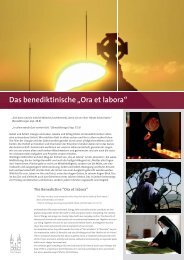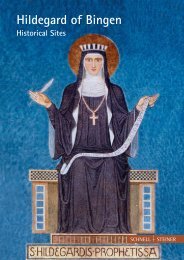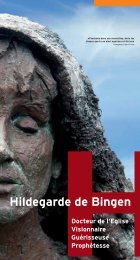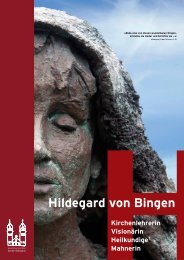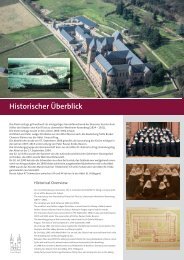hildegard_english_final
Create successful ePaper yourself
Turn your PDF publications into a flip-book with our unique Google optimized e-Paper software.
The Sites<br />
The canonization of Hildegard of Bingen is a<br />
significant development for the Universal Church. I<br />
am delighted that this outstanding person, who is<br />
already held in high esteem in our country, has now<br />
received further recognition. The Abbey of St<br />
Hildegard at Eibingen has become an important<br />
place of pilgrimage and a Hildegard Centre in<br />
Germany. I am grateful that the veneration of St<br />
Hildegard in the Benedictine Order, at the Abbey of<br />
St Hildegard and in the dioceses of Mainz, Trier and<br />
Limburg bears such abundant fruit.<br />
Robert Zollitsch<br />
Archbishop em. of Freiburg<br />
Disibodenberg<br />
Hildegard began her life at Disibodenberg<br />
on 1 November 1112. The women in the<br />
hermitage followed a strict monastic life<br />
according to the Rule of Saint Benedict.<br />
Hildegard received a well-founded, broad monastic education<br />
from her mentor, Jutta of Sponheim: She learned to read, write<br />
and sing, acquired comprehensive knowledge of the Scriptures,<br />
but also closely studied nature, in particular herbs and plants.<br />
At Disibodenberg she wrote her first book, Liber Scivias. In<br />
1147/48 Pope Eugene III was residing at Trier and heard about<br />
Hildegard. He had her visionary gift examined by a commission<br />
and confirmed it.<br />
In a letter he bade her continue with her writing. For Hildegard<br />
this was endorsement, encouragement and stimulation. For<br />
those around her it was definitive proof that the Magistra of<br />
Disibodenberg really was “God’s trumpet”. While all of this was<br />
happening, Hildegard also pursued her intention of founding her<br />
own monastery.<br />
Rupertsberg<br />
Hildegard purchases land at<br />
Rupertsberg near Bingen and with her<br />
nuns built a monastery based on her<br />
own concept. They relocated between<br />
1147 and 1151. A charter in the name of Henry, archbishop of<br />
Mainz, dated 1 May 1152, documents the consecration of the<br />
church. There was a dispute with the abbot of Disibodenberg<br />
concerning Rupertsberg’s independence and its possessions.<br />
Hildegard made use of her good connections and received deeds<br />
which largely safeguard her monastery’s independence. In 1632<br />
Rupertsberg was destroyed during the Thirty Years’ War.<br />
Eibingen<br />
Hildegard’s fame drew many to seek admission at<br />
Rupertsberg. Soon the monastery was too small.<br />
She bought a vacated monastery at Eibingen. It<br />
was rededicated in 1165. Hildegard also became<br />
abbess of this second monastery and crossed the<br />
Rhine twice a week to visit the sisters at Eibingen.<br />
In 1802, as a result of the Secularization, the monastery was<br />
dissolved; all its possessions were lost. In 1831 the monastic<br />
church became the parish church of Eibingen.<br />
New Foundation of the Abbey of St Hildegard<br />
In 1904, after a four years of building, 14 nuns of the<br />
Abbey of St Gabriel in Prague move into the newly<br />
built monastery high above the Rhine. The<br />
monastery is raised to the full status of an abbey<br />
and endowed with all rights and privileges of<br />
Hildegard’s former monasteries. It is exempt<br />
from local episcopal authority and is placed<br />
directly under the jurisdiction of the Holy See.<br />
The community of the Abbey of St Hildegard<br />
regards the study of and care for Hildegard’s<br />
legacy as its pre-eminent concern, passing it<br />
on to contemporaries as a timelessly relevant<br />
message.






